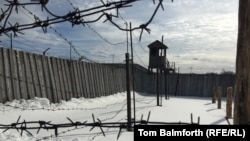PERM, Russia -- The Perm-36 gulag museum in the forests of Western Siberia is under new management -- and it's easy to feel the difference when touring the new team's recently opened first exhibition.
The new presentation is devoted not to the repressive forced-labor practices of the Stalin era, but to timber production at the camp and its contribution to the Soviet victory in World War II.
"During times of great tribulations, during times of profound decisions for the country and the fate of the people, no one remained indifferent," Perm Oblast Culture Minister Igor Gladnev said at the exhibition's opening on July 9. "And this is precisely the main factor, thanks to which we achieved the main victory in the history of humanity. Today we are experiencing a deficit of faith, a deficit of unity. And these are not just pretty words -- we must bring them to some practical form."
"So, glory to the heroes," he concluded. "Glory to those who fought, who laid down their lives in the name of our great victory and the preservation of our country."
Perm-36 is located in a forest about 75 kilometers from the city of Perm. It served as a labor camp for criminals and political prisoners throughout most of the Soviet period, until 1988. In 1992, a group of academics and activists created the Museum of Political Repressions there.
PHOTO GALLERY: Perm-36 -- The Gulag Camp Frozen In Time
In March, however, local officials under conservative Governor Viktor Basargin took over the museum after the Perm-36 group was labeled a "foreign agent" by the government.
"We don't want to take sides," the museum's new head of exhibitions, Yelena Mamayeva, said shortly after being appointed. "We're trying to talk more about the architectural complex [of the camp], and not to get involved in assessing specific people who served sentences there, and assessing Stalin, and so on. Because right now this is not quite politically correct."
'Balanced, Objective' View Of Gulags
The tour guide at the revamped exhibition emphasized that the prisoners were criminals and "dissidents who were involved in anti-Soviet activity." One woman who toured the display said that "all the emphasis" was on criminals and "people who carried out sabotage during the war."
"They even said that some criminals would have anti-Soviet tattoos done so that they could become 'political' prisoners because, supposedly, the conditions for them were better," said the woman, who asked not to be named.
In fact, the vast majority of political prisoners in Stalin's gulag were sentenced on trumped-up charges. They were thrown in together with common criminals, who were often given authority over them by the guards and sometimes sadistically brutalized the politicals.
Local Soviet-educated historian and former Communist Party of the Soviet Union member Mikhail Suslov also addressed the opening of the new exhibition.
"I am surprised that I do not see either in the press or in journalistic pieces anything about how the prisoners lived," he said. "After all, they performed concerts and made shows. During the war years alone, more than 100,000 shows were organized at prison facilities. They had libraries -- that is, there was a cultural life in the camps, but now they are showing us a somewhat different picture. I propose that we historians need to work to create a balanced, objective picture of what happened."
'Justifying The Gulag'
The figure of 100,000 shows performed in the camps during the war years might be accurate, says Viktor Shmyrov, a founder of the original Perm-36 museum who was not invited to the opening, but the vast majority of them were not "cultural" events but were forcibly staged propaganda events.
Shmyrov says historians like Suslov are "justifying the gulag."
"And this is monstrous," Shmyrov told RFE/RL's Russian Service. "This can go very far. What can I say -- portraits of Stalin are already appearing in the streets of the city."
Local pensioner Mikhail Plekhanov toured the exhibition and decided that "the conditions for the condemned were acceptable" and "the state had the right to use the labor of prisoners."
"About this small exhibition, I can only say one thing," Plekhanov added. "The forest is an asset of our Motherland that was particularly valuable during the war. First, timber was needed for defense, for trenches and shelters. Secondly, it was needed for rebuilding. It was very interesting for me to visit this place and see how the people who gave us this timber lived."
Shmyrov says, to take one figure, 20 percent of the camp's prisoners died during 1943. Historian Vitaly Mingalev gives similarly appalling mortality figures for the nearby Ponyshlag camp, which held 6,700 prisoners in mid-1943: in July 1944, 139 prisoners died; in August, 309; in September, 276.
Shmyrov's group has found a note written by a Ponyshlag administrator in the spring of 1944: "Almost half of the beds have no mattresses or blankets and the prisoners have to sleep on bare boards...without undressing. About half of the prisoners have worn-out shoes, and many of them have practically no clothes or shoes at all."
Exhibition director Mamayeva opened the revamped museum with a personal anecdote.
"My great-grandmother was in the category of those specially resettled," she told the gathering. "In the 1940s-50s, when she had two small children to take care of and her husband was at the front, she committed theft. She carried away some grain in her shoes. She was sentenced to 10 years, which she served at a timber camp."
"When we were putting together this exhibition," Mamayeva continued, "and we were carrying the logs, we got a sense of how hard the work was. But it is important to note that the timber firms hired workers not only from among the locals but also signed labor agreements with the labor camps to hire prisoners. And they had to pay both types [of workers]. So it is not justified to speak about 'slave labor.' At the same time -- there was no compensation for either type of worker for the difficulty of the work."
"But that was our region's contribution to victory," she concluded.















